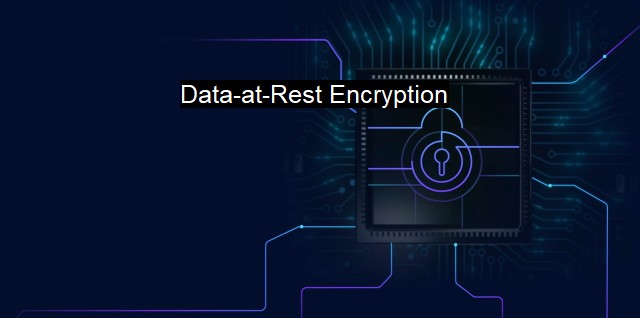What is Data-at-Rest Encryption?
The Significance of Data-at-Rest Encryption in Antivirus Solutions: A Comprehensive Analysis of Modern Cybersecurity
Data-at-rest encryption is a popular strategy used in cybersecurity that involves encrypting data stored in a fixed place. As the name suggests, "data-at-rest" refers to any data stored physically in any digital format in various locations like databases, data warehouses, spreadsheets, archives, mobile devices, or elsewhere within an organization's systems where it lies idle and is not in use or being transmitted over a network.Typically, data-at-rest is considered more secure than data in transit due to its stagnant state. it is still vulnerable to unauthorized access if the systems where it resides end up compromised, which makes data-at-rest encryption a vital tool for data protection in the context of cybersecurity.
Encryption is essentially the process by which information is converted into secret code, rendering it unreadable to any entity that doesn't have the decryption key. Data-at-rest encryption, therefore, refers to the strategic encryption of data stored in stationary states across physical systems. This ensures that should the data fall into the wrong hands, unauthorized users will be unable to extract meaningful information from the encrypted data due to the unreadable format it will assume after encryption.
Data-at- rest encryption primarily targets sensitive stored data such as personal identification data, proprietary business data, customer data, and the bulk of classified administrative data that if compromised, could have devastating implications on business integrity, data privacy, and overall agency of operational processing. It is, therefore, seen as a line of defense in the security structure of any cyber-protected system serving to stave off data breaches, hijacks, thefts, and unauthorized access.
Data-at-rest encryption is used indiscriminately not just in server data, but it can extend its capabilities to encrypt data across a set of diverse platforms including cloud storage, data archives, laptops, bar-code readers, smartphones, and tablets. This broadly perpetuates the scope of its applicability in ensuring cybersecurity, ranging from personal to professional domains.
In the context of antivirus, data-at-rest encryption plays a substantial role. Antivirus software protects digital systems from malicious attacks aimed at data theft or disruption. For instance, ransomware — a type of malware — often locks users out of their systems or personal files and demands ransom for access reinstatement. If the data was encrypted, the attacker would be unable to compromise or leverage the information, even if he succeeds to infiltrate the system.
Data-at-rest encrypting not only ensures data protection but also regulatory compliance. Many security regulations and data protection laws necessitate the encryption of certain types of data. For instance, health information under the Health Insurance Portability and Accountability Act (HIPAA) or credit card data under the Payment Card Industry Data Security Standard (PCI DSS) needs to be encrypted when they are in a rest state.
Two common types of data-at-rest encryption include full-disk encryption (FDE) and transparent database encryption (TDE). FDE, as the name suggests, encrypts the whole drive – all texts, files, and applications. On the other hand, TDE encrypts data at the column-level within a database, ensuring that information remains protected even if the file system or platform is susceptible.
To sum up, data at rest encryption emerges as a significant aspect of cybersecurity aimed at safeguarding classified data against unauthorized access and breach. It acts as an added layer of protection encrypting data that resides in storage and is not migrating across networks. By making the data unreadable and therefore unusable to those without the decryption key, data-at-rest encryption helps deter cyber threats and comply with data protection regulations, highlighting its importance in today's digital environments where data breaches and cyber attacks are common.

Data-at-Rest Encryption FAQs
What is data-at-rest encryption and why is it important in cybersecurity?
Data-at-rest encryption is the process of securing data stored in devices such as hard drives, flash drives, and other storage media. It is important in cybersecurity because it protects sensitive and confidential data from unauthorized access in case the devices are lost or stolen.What are the benefits of using data-at-rest encryption?
The benefits of using data-at-rest encryption include protecting against unauthorized access to sensitive data, reducing the risk of data breaches, helping businesses meet regulatory compliance requirements, and providing an additional layer of security in case other security measures fail.Is data-at-rest encryption better than antivirus software for protecting data?
Data-at-rest encryption and antivirus software serve different purposes, so it's not a matter of one being better than the other. Antivirus software is designed to prevent, detect, and remove malware from computer systems, while data-at-rest encryption is aimed at securing stored data from unauthorized access. Both tools can be used together to provide a comprehensive security solution.How can I implement data-at-rest encryption in my business?
To implement data-at-rest encryption, you need to first assess your business's data storage needs and determine what types of encryption methods will work best for you. You can use software solutions such as BitLocker, VeraCrypt, or Symantec Endpoint Encryption to encrypt data stored on devices. It's also imperative to train employees on best practices for data handling and storage to ensure that sensitive data remains protected.| | A | | | B | | | C | | | D | | | E | | | F | | | G | | | H | | | I | | | J | | | K | | | L | | | M | |
| | N | | | O | | | P | | | Q | | | R | | | S | | | T | | | U | | | V | | | W | | | X | | | Y | | | Z | |
| | 1 | | | 2 | | | 3 | | | 4 | | | 7 | | | 8 | | |||||||